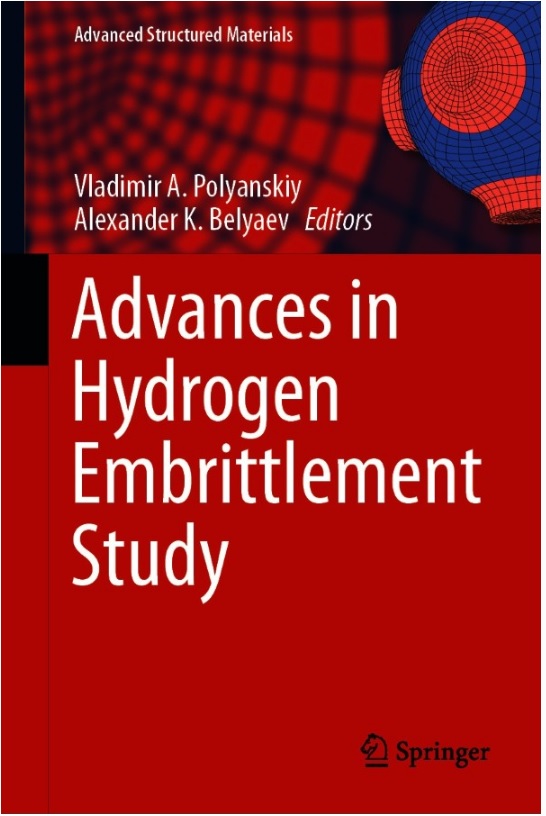Effect of Hydrogen Concentration and Strain Rate on Hydrogen Embrittlement of Ultra-Fine-Grained Low-Carbon Steel
 Chapter 10 in book Advances in Hydrogen Embrittlement Study. Book Editors: Vladimir A. Polyanskiy, Alexander K. Belyaev / Springer International Publishing, Cham., Book Series Advanced Structured Materials, 2021, Volume 143. pp. 159-170.
Chapter 10 in book Advances in Hydrogen Embrittlement Study. Book Editors: Vladimir A. Polyanskiy, Alexander K. Belyaev / Springer International Publishing, Cham., Book Series Advanced Structured Materials, 2021, Volume 143. pp. 159-170.
Authors: Evgeniy D. Merson, Pavel N. Myagkikh, Gennadiy V. Klevtsov, Dmitri L. Merson, Alexei Yu. Vinogradov
About this book
The book presents a collection of chapters on the current problems associated with hydrogen damage. It discusses the effect of hydrogen on material properties and its interaction with the material microstructure, physical features of hydrogen transport in metals and alloys, as well as applicable methods of measuring concentration of hydrogen in solid media.
Softcover ISBN: 978-3-030-66950-8 |Series E-ISSN: 1869-8441 |eBook ISBN:978-3-030-66948-5 |Series ISSN: 1869-8433 |DOI: 10.1007/978-3-030-66948-5
Preface book
Hydrogen greatly influences the properties of various materials which is important for almost all industrial technologies. Hydrogen can enter the molten metal and remain in it after solidification. During the exploitation of metal parts, hydrogen saturation occurs due to corrosion, friction, or plastic deformation. Water is the most common source of hydrogen. The properties of metals are drastically affected in the presence of any additives. They become brittle, crack, and lose durability. Only one hydrogen atom per hundreds of thousands of metal atoms is enough while other impurities can cause some harm only in much higher concentrations reaching a fraction of a percent. A small concentration of hydrogen is difficult to fix, which makes difficult the direct measurement of its content in metals. That is why various approaches to the problem of hydrogen diffusion and distribution in metals are attracting a vivid attention of the researchers from many countries.
In consideration of success of workshop on advances in hydrogen embrittlement study which took place in the framework of the First International Conference “Corrosion in the oil & gas industry” in St. Petersburg in May 2019, we feel honoured and privileged to present a collection of papers in this volume “Advances in hydrogen embrittlement study” in the world leading publisher Springer. The workshop covered, among the others, the subjects that reflected some challenging research items in theoretical and experimental studies. These include both developing adequate experimental techniques for characterizing fracture/damage and efficient theoretical and numerical approaches. The volume contains predominantly the papers presented at the above workshop and completed by new scientific achievements in a number of papers by the world experts in the field of hydrogen–metal interaction.
Vladimir A. Polyanskiy, Alexander K. Belyaev
Table of Contents Chapter 10 "Effect of Hydrogen Concentration and Strain Rate on Hydrogen Embrittlement of Ultra-Fine-Grained Low-Carbon Steel":
10.1 Introduction
10.2 Experimental
10.3 Results and Discussion
10.3.1 Microstructure
10.3.2 Gas Analysis
10.3.3 Mechanical Testing
10.3.4 Fractography
10.4 Summary and Conclusions
References
Abstract Chapter 10 "Effect of Hydrogen Concentration and Strain Rate on Hydrogen Embrittlement of Ultra-Fine-Grained Low-Carbon Steel"
During the last few decades, keen attention has been paid to the advanced steels with the ultra-fine-grained (UFG) microstructure manufactured by severe plastic deformation (SPD) techniques. Although these materials often demonstrate prominent mechanical properties, the detrimental environmentally induced effects, such as hydrogen embrittlement (HE), which may appear during their service life, have been just scarcely studied. In particular, the influence of the hydrogen concentration and strain rate, which are among the main factors controlling HE, in general, has not been considered in UFG ferritic steels as yet. Thus, the objective of the present study was to examine the effect of these factors on the mechanical behaviour and fracture mode of the low-alloy steel processed by ECAP in comparison with the conventionally fabricated counterparts. The ECAPed and as-received specimens of the low-alloy steel grade 09G2S were cathodically hydrogen charged at different current densities and then subjected to tensile testing at two different strain rates. The diffusible hydrogen concentration in the specimens before tensile testing was assessed by the hot extraction method. After hydrogen charging both as-received and ECAPed specimens demonstrate HE the extent of which increases with the increasing hydrogen concentration and decreasing strain rate. It is found that the ECAPed steel occludes much higher hydrogen concentration than the as-received one. At the given hydrogen concentration, the ECAPed specimens demonstrate stronger hydrogen-induced ductility loss as well as a fundamentally different fracture mode in comparison to the as-received counterparts.
Chapter DOI: https://link.springer.com/chapter/10.1007%2F978-3-030-66948-5_10
Keywords
Hydrogen embrittlement, Equal-channel angular pressing, Low-carbon steel
Cite this chapter as:
Merson E.D., Myagkikh P.N., Klevtsov G.V., Merson D.L., Vinogradov A. (2021) Effect of Hydrogen Concentration and Strain Rate on Hydrogen Embrittlement of Ultra-Fine-Grained Low-Carbon Steel. In: Polyanskiy V.A., Belyaev A.K. (eds) Advances in Hydrogen Embrittlement Study. Advanced Structured Materials, vol 143. Springer, Cham. https://doi.org/10.1007/978-3-030-66948-5_10